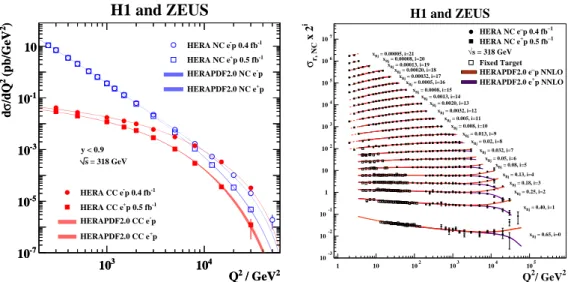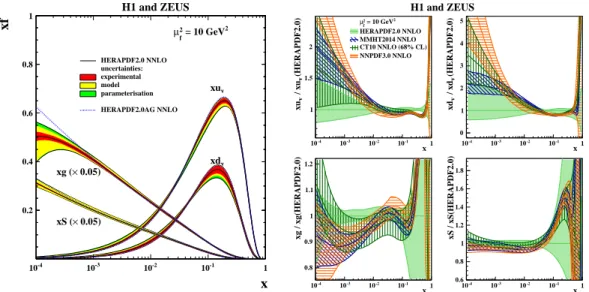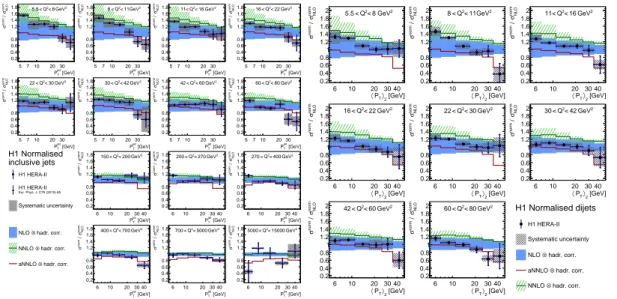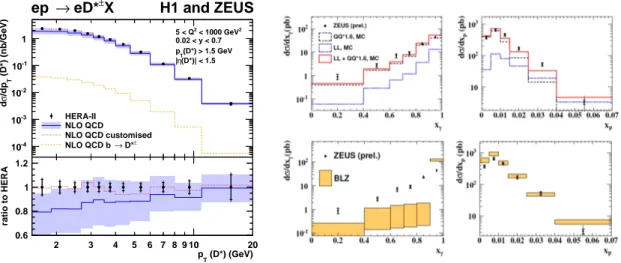PoS(ICHEP2016)617
Vladimir Chekelian ∗ †
Max Planck Institute for Physics, Munich
The H1 and ZEUS collaborations at the electron-proton collider HERA have measured inclusive neutral and charged current deep inelastic scattering (DIS) cross sections over six orders of mag- nitude in negative four-momentum-transfer squared, Q 2 , and Bjorken x. All these measurements were combined to obtain one coherent inclusive HERA data set. This set was used as the sole input to the QCD analysis resulting in the HERAPDF2.0 set of parton distribution functions. An inclusion of HERA data on jet and charm production to the QCD fit allowed a simultaneous deter- mination of parton distributions and the strong coupling. An extension of earlier measurements on multijet production in DIS at high Q 2 to low values of Q 2 and to low values of the jet transverse momentum at high Q 2 is presented here as well as. A combination of the final H1 and ZEUS inclusive D ∗± -meson production cross sections in DIS as a function of Q 2 , inelasticity y and D ∗± - meson variables, and a measurement of isolated photon production in DIS accompanied by jets using the ZEUS detector are also presented. All these results are compared to QCD calculations.
38th International Conference on High Energy Physics 3-10 August 2016
Chicago, USA
∗
Speaker.
†
On behalf of the H1 and ZEUS Collaborations.
PoS(ICHEP2016)617
1. Introduction
Deep inelastic scattering (DIS) of electrons 1 on protons at the electron-proton collider HERA has been central to the exploration of proton structure, quark–gluon dynamics and the theory of strong interactions as described by perturbative Quantum Chromodynamics (pQCD). HERA was operated from 1992 to 2007 with an electron beam energy of E e = 27.5 GeV and proton beam energy of E p = 920(820) GeV, corresponding to a centre-of-mass energy of √
s ≃ 320 (300) GeV.
At the end of data taking the proton beam energy was reduced to E p = 575 and 460 GeV, corre- sponding to √
s ≃ 251 and 225 GeV. The H1 and ZEUS collaborations at HERA collected total integrated luminosities of approximately 500 pb − 1 each, shared about equally between e + p and e − p scattering.
All H1 and ZEUS inclusive neutral (NC) and charged current (CC) deep inelastic e ± p cross section measurements were combined [1] with a careful treatment of correlated systematic uncer- tainties and global normalisations of the data in the combination in order to obtain one coherent inclusive HERA data set. The dependencies of the combined NC and CC inclusive HERA cross sections on Bjorken x and negative four-momentum-transfer squared, Q 2 , were analysed in the pQCD framework to determine a new set of quark and gluon momentum distributions in the pro- ton, denoted as HERAPDF2.0 [1], at leading (LO), next-to-leading (NLO) and next-to-next-to- leading (NNLO) orders in the strong coupling α s . An inclusion of the HERA data on jet and charm production to the pQCD analysis allowed a simultaneous determination of the parton distribution functions (PDFs) and α s .
Recently, the H1 collaboration reported about an extension [2] of earlier measurements on inclusive jet, dijet and trijet production in DIS at high Q 2 [3] to low values of Q 2 and to low values of the jet transverse momentum at high Q 2 . The jet cross section measurements were compared to NLO, approximate NNLO [4] and to full NNLO [5] QCD calculations.
The final H1 and ZEUS cross sections for inclusive D ∗± -meson production in DIS were com- bined [6] in the visible phase space as a function of Q 2 , inelasticity y, and as a function of D ∗± - meson variables. The results were compared to perturbative NLO QCD predictions.
Further measurements of the production of isolated photons accompanied by jets in DIS [7]
were accomplished using the ZEUS detector. The measured cross sections were compared to Monte Carlo (MC) simulation and to QCD calculations based on the k T factorisation method.
2. Combination of inclusive NC and CC data at HERA and HERAPDF2.0
In order to combine all inclusive NC and CC deep inelastic cross section measurements pub- lished by H1 and ZEUS, they were translated onto common x, Q 2 grids and averaged [1]. In total 41 data sets from H1 and ZEUS entered into this combination. The 2927 published cross sections from these 41 data sets were combined to become 1307 combined cross-section measurements for values of Q 2 between Q 2 = 0.045 GeV 2 and Q 2 = 50000 GeV 2 , and for values of x between x = 6 × 10 − 7 and x = 0.65. For the resulting 1620 degrees of freedom, a χ 2 = 1687 was obtained, indicating consistency of the input data. The total uncertainties for NC are below 1.5 % over the Q 2 range of 3 ≤ Q 2 ≤ 500 GeV 2 and below 3 % up to Q 2 = 3000 GeV 2 .
1
The word “electron" in the paper refers to both electrons and positrons, unless otherwise stated.
PoS(ICHEP2016)617
/ GeV
2Q
210
310
4)
2(pb/GeV
2/dQ σ d
10
-710
-510
-310
-110
H1 and ZEUS
y < 0.9 = 318 GeV s
p 0.4 fb-1
HERA NC e-
p 0.5 fb-1
HERA NC e+ -p HERAPDF2.0 NC e
+p HERAPDF2.0 NC e
p 0.4 fb-1
HERA CC e-
p 0.5 fb-1
HERA CC e+ -p HERAPDF2.0 CC e
+p HERAPDF2.0 CC e
/ GeV
2Q
210
310
4)
2(pb/GeV
2/dQ σ d
10
-710
-510
-310
-110
H1 and ZEUS
xBj = 0.00005, i=21 xBj = 0.00008, i=20
xBj = 0.00013, i=19 xBj = 0.00020, i=18
xBj = 0.00032, i=17 xBj = 0.0005, i=16
xBj = 0.0008, i=15 xBj = 0.0013, i=14
xBj = 0.0020, i=13 xBj = 0.0032, i=12
xBj = 0.005, i=11 xBj = 0.008, i=10
xBj = 0.013, i=9 xBj = 0.02, i=8
xBj = 0.032, i=7 xBj = 0.05, i=6 xBj = 0.08, i=5
xBj = 0.13, i=4 xBj = 0.18, i=3
xBj = 0.25, i=2
xBj = 0.40, i=1
xBj = 0.65, i=0
Q
2/ GeV
2σ
r, NCx 2
iHERA NC e+p 0.5 fb–1 HERA NC e– p 0.4 fb–1
√s = 318 GeV Fixed Target HERAPDF2.0 e+p NNLO HERAPDF2.0 e –p NNLO
10-3 10-2 10-1 1 10 102 103 104 105 106 107
1 10 102 103 104 105
Figure 1: Left: The combined HERA NC and CC e − p and e + p cross sections, d σ /dQ 2 , together with predictions from HERAPDF2.0 NLO. Right: The combined HERA data for the inclusive NC e + p and e − p reduced cross sections together with fixed-target data and the predictions of HERAPDF2.0 NNLO.
The combined NC and CC cross sections for e − p and e + p scattering, integrated to obtain the single-differential cross sections d σ /dQ 2 , are shown in Fig. 1 (left). Whereas the NC cross sections are three orders of magnitude larger at low Q 2 ≈ 100 GeV 2 , where they are dominated by virtual photon exchange, the NC and CC cross sections become similar in magnitude at Q 2 ≈ 10000 GeV 2 , i.e. at around the mass-scale squared of the electroweak bosons, demonstrating the success of electroweak unification in the Standard Model.
The dominant contribution to the NC cross section is due to the proton structure function F 2 . Therefore, the combined reduced NC cross sections shown in Fig. 1 (right) reveal the main properties of this proton structure function. At x ≃ 0.1 they are independent of Q 2 demonstrating scaling of F 2 in this region. At higher and lower values of x one observes scaling violations of F 2 due to emission of gluons from quarks and splitting of gluons into quark-antiquark pairs, respectively.
From the difference of the combined e − p and e + p NC cross sections at Q 2 ≥ 1000 GeV 2 , the proton structure function xF 3 γ Z was measured as well.
The combined inclusive e ± p NC and CC cross section data were used as the sole input in the
pQCD analysis, resulting in the PDF set called HERAPDF2.0 [1]. In this analysis the predictions
obtained by solving the DGLAP evolution equations at LO, NLO and NNLO in the MS scheme
were fitted to the combined inclusive HERA data. The DGLAP equations yield the PDFs at all
scales µ f 2 and x, if they are provided as functions of x at some starting scale. In variable-flavour-
number schemes, this scale has to be below the charm-quark mass parameter, M c , squared. It
was chosen to be 1.9 GeV 2 . The renormalisation and factorisation scales were taken to be Q 2 .
The heavy-quark coefficient functions were calculated in the general-mass variable-flavour-number
scheme called RTOPT [8] for the NC structure functions. For the CC structure functions, the zero-
mass approximation was used, since all HERA CC data have Q 2 ≫ M b 2 , where M b is the beauty-
quark mass parameter in the calculation. The value of M c and M b were chosen after performing
PoS(ICHEP2016)617
0.2 0.4 0.6 0.8 1
10-4 10-3 10-2 10-1 1
HERAPDF2.0 NNLO uncertainties:
experimental model parameterisation HERAPDF2.0AG NNLO
x
xf
2 = 10 GeV2µf
xuv
xdv
0.05)
× xS (
0.05)
× xg (
H1 and ZEUS
x 10 -4 10 -3 10 -2 10 -1 1 xu / xu (HERAPDF2.0)vv
1 1.5 2
= 10 GeV2 f µ2
HERAPDF2.0 NNLO MMHT2014 NNLO CT10 NNLO (68% CL) NNPDF3.0 NNLO
x 10 -4 10 -3 10 -2 10 -1 1 xd / xd (HERAPDF2.0)vv
0 1 2 3 4 5
x 10 -4 10 -3 10 -2 10 -1 1
xg / xg(HERAPDF2.0)
0.8 0.9 1 1.1 1.2
x 10 -4 10 -3 10 -2 10 -1 1
xS / xS(HERAPDF2.0)
0.6 0.8 1 1.2 1.4 1.6 1.8
H1 and ZEUS
Figure 2: The parton distribution functions xu v , xd v , xS = 2x( U ¯ + D) ¯ and xg at µ f 2 = 10 GeV 2 . Left: HERA- PDF2.0 NNLO with the experimental, model and parameterisation uncertainty bands and HERAPDF2.0AG NNLO represented by the dotted lines; xS and xg are scaled down by a factor of 20. Right: The ratios of the NNLO PDFs of HERAPDF2.0, MMHT2014, CT10 and NNPDF3.0 with corresponding uncertainty bands to the central PDF values of HERAPDF2.0 NNLO.
χ 2 scans of NLO and NNLO pQCD fits to the combined inclusive data together with the HERA combined charm data [9] or with data on beauty production from H1 [10] and ZEUS [11]. The value of the strong coupling constant at the Z-boson mass scale, α s (M Z ), was taken to be α s (M Z ) = 0.118(0.130) for the fits at NLO and NNLO (LO).
In the approach of HERAPDF, the PDFs of the proton, x f , are generically parameterised at the starting scale as x f (x) = Ax B (1 − x) C (1 + Dx + Ex 2 ) . The PDFs parameterised are the gluon distribution, xg, the valence-quark distributions, xu v , xd v , and the u-type and d-type anti-quark distributions, x ¯ U , x ¯ D. The relations x ¯ U = x ¯ u and x ¯ D = x ¯ d +x ¯ s are assumed at the starting scale. In the gluon distribution, xg, an additional term of the form A ′ g x B
′g(1 − x) C
g′was subtracted at NLO and NNLO to allow more flexibility for the gluon distribution. The fits without this term are marked by adding “AG” (alternative gluon) to the fit notation. In total 14 free parameterisation parameters were determined in the central fits.
To safely remain in the kinematic region where pQCD is expected to be applicable, only cross sections for Q 2 starting from Q 2 min = 3.5 GeV 2 were used in the analysis. In this kinematic region, target-mass corrections and large-x higher-twist corrections are expected to be negligible.
Experimental uncertainties were determined using the Hessian method with the criterion ∆χ 2 = 1, justified by the consistency of the input HERA data. In addition to experimental uncertainties, model and parameterisation uncertainties were also considered.
Using the settings discussed above, the HERAPDF2.0 sets of PDFs were determined at NNLO,
NLO and LO. A summary of HERAPDF2.0 NNLO is shown in Fig. 2 (left) at the scale µ f 2 =
10 GeV 2 . The experimental, model and parameterisation uncertainties are shown separately. At
NNLO, the gluon distribution of HERAPDF2.0 ceases to rise at low x in contrast to HERA-
PDF2.0AG NNLO obtained using the alternative, positively defined, gluon parameterisation.
PoS(ICHEP2016)617
[GeV]
jet PT
5710 20 30
NLOnormσ / normσ
0.2 0.4 0.6 0.8 1 1.2 1.4 1.6 1.8 5.5<Q2<8GeV2
[GeV]
jet PT
5710 20 30
NLOnormσ / normσ
0.2 0.4 0.6 0.8 1 1.2 1.4 1.6 1.8 8<Q2<11GeV2
[GeV]
jet PT
5710 20 30
NLOnormσ / normσ
0.2 0.4 0.6 0.8 1 1.2 1.4 1.6 1.8 11<Q2<16GeV2
[GeV]
jet PT
5710 20 30
NLOnormσ / normσ
0.2 0.4 0.6 0.8 1 1.2 1.4 1.6 1.8 16<Q2<22GeV2
[GeV]
jet PT
5710 20 30
NLOnormσ / normσ
0.2 0.4 0.6 0.8 1 1.2 1.4 1.6 1.8 22<Q2<30GeV2
[GeV]
jet PT
5710 20 30
NLOnormσ / normσ
0.2 0.4 0.6 0.8 1 1.2 1.4 1.6 1.8 30<Q2<42GeV2
[GeV]
jet PT
5710 20 30
NLOnormσ / normσ
0.2 0.4 0.6 0.8 1 1.2 1.4 1.6 1.8 42<Q2<60GeV2
[GeV]
jet PT
5710 20 30
NLOnormσ / normσ
0.2 0.4 0.6 0.8 1 1.2 1.4 1.6 1.8 60<Q2<80GeV2
inclusive jets H1 Normalised
H1 HERA-II
Eur. Phys. J. C75 (2015) 65 H1 HERA-II
Systematic uncertainty
[GeV]
jet PT
6 10 2030 40
NLOnormσ / normσ
0.2 0.4 0.6 0.8 1 1.2 1.4 1.6 1.8 150<Q2<200GeV2
[GeV]
jet PT
6 10 2030 40
NLOnormσ / normσ
0.2 0.4 0.6 0.8 1 1.2 1.4 1.6 1.8 200<Q2<270GeV2
[GeV]
jet PT
6 10 2030 40
NLOnormσ / normσ
0.2 0.4 0.6 0.8 1 1.2 1.4 1.6 1.8 270<Q2<400GeV2
hadr. corr.
⊗ NLO
hadr. corr.
⊗ NNLO
hadr. corr.
⊗ aNNLO
[GeV]
jet PT
6 10 2030 40
NLOnormσ / normσ
0.2 0.4 0.6 0.8 1 1.2 1.4 1.6 1.8 400<Q2<700GeV2
[GeV]
jet PT
6 10 2030 40
NLOnormσ / normσ
0.2 0.4 0.6 0.8 1 1.2 1.4 1.6
1.8 700<Q2<5000GeV2
[GeV]
jet PT
6 10 2030 40
NLOnormσ / normσ
0.2 0.4 0.6 0.8 1 1.2 1.4 1.6
1.85000<Q2<15000GeV2
[GeV]
〉2 PT 6 10 20〈 30 40 NLOnormσ / normσ
0.2 0.4 0.6 0.8 1 1.2 1.4 1.6 1.8
2 5.5<Q2<8 GeV2
[GeV]
〉2 PT 6 10 〈20 30 40 NLOnormσ / normσ
0.2 0.4 0.6 0.8 1 1.2 1.4 1.6 1.8
2 8<Q2<11GeV2
[GeV]
〉2 PT 6 10 20〈 30 40 NLOnormσ / normσ
0.2 0.4 0.6 0.8 1 1.2 1.4 1.6 1.8
2 11<Q2<16GeV2
[GeV]
〉2 PT 6 10 20〈 30 40 NLOnormσ / normσ
0.2 0.4 0.6 0.8 1 1.2 1.4 1.6 1.8
2 16<Q2<22GeV2
[GeV]
〉2 PT 6 10 〈20 30 40 NLOnormσ / normσ
0.2 0.4 0.6 0.8 1 1.2 1.4 1.6 1.8
2 22<Q2<30GeV2
[GeV]
〉2 PT 6 10 20〈 30 40 NLOnormσ / normσ
0.2 0.4 0.6 0.8 1 1.2 1.4 1.6 1.8
2 30<Q2<42GeV2
[GeV]
〉2 PT 6 10 20〈 30 40 NLOnormσ / normσ
0.2 0.4 0.6 0.8 1 1.2 1.4 1.6 1.8
2 42<Q2<60GeV2
[GeV]
〉2 PT 6 10 〈20 30 40 NLOnormσ / normσ
0.2 0.4 0.6 0.8 1 1.2 1.4 1.6 1.8
2 60<Q2<80GeV2 H1 Normalised dijets H1 HERA-II Systematic uncertainty
hadr. corr.
⊗ NLO
hadr. corr.
⊗ aNNLO
hadr. corr.
⊗ NNLO
Figure 3: The normalised double differential cross section measurements for inclusive jets (left) and dijets (right) divided by the NLO calculations corrected for hadronisation. The aNNLO and NNLO predictions are shown as well.
The PDFs of HERAPDF2.0 NNLO are compared in Fig. 2 (right) to MMHT2014 [12] using the same heavy-flavour scheme, i.e. RTOPT, to CT10 [13] with a heavy-flavour-scheme based on ACOT, and to NNPDF3.0 [14] with the FONLL scheme. All PDFs are compatible taking into ac- count full uncertainties. The variants of the QCD fit, HERAPDF2.0FF3A and HERAPDF2.0FF3B, were obtained using fixed-flavour-number schemes, which are similar to ABM11 FF(3N) [15] and NNPDF3.0 FF(3N) [14], respectively. Another variant HERAPDF2.0HiQ2, with a larger value of Q 2 min , Q 2 min = 10 GeV 2 , was obtained. An extension of the analysis by including HERA data on jet and charm [9] production, denoted as HERAPDF2.0Jets, made a simultaneous determina- tion of parton distributions and the strong coupling constant at the scale M Z possible. The χ 2 and the resulting PDFs of the HERAPDF2.0Jets fit are very close to the values for the fit with fixed α s (M Z ) = 0.118. The result, α s (M Z ) = 0.1183 ± 0.0009(exp) ± 0.0005(model/param.) ± 0.0012(hadron.) +0.0037 − 0.0030 (scale), is compatible with the world average [16] and competitive with other determinations at NLO.
3. Multijets in DIS and theory predictions at NNLO
In the QCD fit leading to HERAPDF2.0Jets [1], mentioned in the previous section, the H1 measurements of the inclusive jet, dijet and trijet cross sections at high Q 2 [3] were included.
Recently, the H1 collaboration reported an extension [2] of these measurements to low Q 2 , 5.5 <
Q 2 < 80 GeV 2 , and the transverse momentum 4.5 < P T jet < 50 GeV. Additionally, inclusive jets at low P T jet , 5 < P T jet < 7 GeV, and high Q 2 , 150 < Q 2 < 15000 GeV 2 , were measured as well. The jet cross sections were divided by the inclusive NC DIS cross sections in the corresponding Q 2 -bins to obtain normalised jet cross sections.
Jets were reconstructed using the inclusive k T algorithm in the Breit frame and were required
to have a minimum transverse momentum of 4 GeV. The precision of the jet cross section measure-
PoS(ICHEP2016)617
ments is in the range of 6% to 20% in the central parts of the phase space. The results for inclusive jet and dijet double differential cross sections as functions of Q 2 and P T or of Q 2 and the average transverse momentum of two jets in the dijets events, < P T jet > 2 , are shown in Fig. 3 (left and right) divided by the pQCD calculations at NLO corrected for hadronisation effects. New theoretical calculations in the threshold resummation formalism with 2-loop contributions (aNNLO) [4] and new predictions in full NNLO [5] perturbative QCD are also shown. For the theory calculations the PDFs of NNPDF3.0 at NLO and NNLO were used. The predictions in NNLO perturbative QCD improve the descriptions for inclusive jet and dijet cross sections compared to NLO predictions, and give an overall good description of the data. The sensitivity of the jet data to the extraction of the strong coupling constant and to the running of α s was studied in a fit to NLO predictions. The α s (M Z ) value from the H1 normalised jet data in the range 5.5 < Q 2 < 15000 GeV 2 was found to be α s (M Z ) = 0.1173 ± 0.0004(exp) +0.0053 − 0.0045 (theory), demonstrating the high experimental precision of the data.
(D*) (nb/GeV)T/dpσd
10-4
10-3
10-2
10-1
1
(D*) (GeV)
T
p
2 3 4 5 6 7 8 9 10 20
ratio to HERA
0.6 0.8 1 1.2
HERA-II NLO QCD NLO QCD customised
D*±
→ NLO QCD b
< 1000 GeV2
5 < Q2
0.02 < y < 0.7 (D*) > 1.5 GeV pT
(D*)| < 1.5 η
|



